Use of Myth and Symbolism in 20th Century Poetry
Symbolism is to convey the hidden meaning to the reader or listener. It tells us about artistic expression and represents abstract ideas. However, it is not limited to poetry and literature. Symbolism is one of the most important elements which gives depth to art; it can be the color of the painting or the depiction of characters that are significant to symbolic to some specific themes. A painter uses symbolism when he wants to put emotions and ideas in the picture which we can't experience with our five senses. It's all about showing instead of telling. Here are a few examples of symbolism in art.
Jupiter and Semele – Gustave Moreau
This painting depicts the myth that tells us about the love of Jupiter and the divine god of gods; Semele. This painting is symbolic of humanity's union with the divine that ends in death. Themes of death, corruption, and resurrection all appeared in this painting. The figure of Jupiter suggests the isolation of the dreaming artist and the life of ideas. This painting is also symbolic of the neuroses (obsessions) of the modern age.
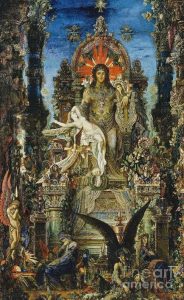
The Eye Like A Strange Balloon Mounts Towards Infinity – Odilon Redon
In the above art, the large scale of the eye is the symbol of the spirit rising up out of the dead matter of the swamp. The physical organ which is looking up towards the divine is carrying a skull. This work evokes a sense of mystery within a dream world. The head is a symbol of the origin of imagination.

Death And The Mask – James Ensor
In this work, Ensor imparts life-like qualities to the skull of death in the center, with its chilling grin, and to the mask of the people. The mask is trying to cover up the spiritual hollowness of the decadence of the times. The light and bright palette suggest the whimsy and absurdity of his time. The raw colors and savage texture are the symbols to strip down to the layers of the human psyche which is plumbing its depth.

The Three Brides – Jan Toorop
The scrawny figures with spindly arms and emphatic gestures derive from Javanese puppet theatre. Here, Jan puts up three stages of the soul, consisting of the bride dedicated to Christ, the bride dedicated to earthly love and satanic bride- adorned with the necklace of a small skull and holding a small snake. The bowl of blood symbolizes the purity of emotions and passions. The bed of thorns is symbolic of pains. The bells in nailed fingers are symbolic of the sound of bells within the artist and evoking of senses. The artist tries to relate humans to the spiritual world.
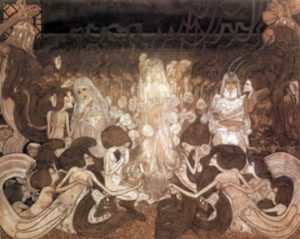
The Dance Of Life – Edvard Munch
This art piece presents the three stages of woman. The woman in white is a symbol for virgin; the red one is symbolic for a carnal woman of experience and the woman in black is satanic who is shown aged one. The scene in the back symbolizes the eternity, vast unknown and finally death. The dance is symbolic of worldly works and merry-making. The dance of life is thus also a dance of death. The theme of alienation and isolation is also very well depicted.
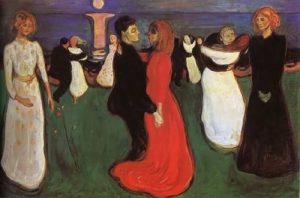
The Yellow Christ – Paul Gaugin
It shows the crucifixion of Christ taking place in the nineteenth century. The yellow color is a symbol of isolation and piety of the peasants. The dresses of characters represent the regions they belong to. The background in autumn is actually the desire to get away from city life.
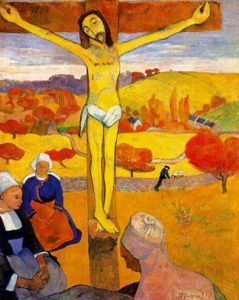
The Crying spider – Odilon Redon
This piece shows a crying spider with nine legs painted in charcoal. The human face on the nine legs with eyes unfilled and hollow tells the hollowness of the desires and world. Spider has the meaning of how we construct the web of our choices, and then we trap ourselves in them. The tears are symbolic of the regrets in life. The colorless background stands for the fake lives we are living in.

Hope – George Frederic
It presents a blindfolded female sitting on a globe, playing the lyre with a single string. The background is blank. The picture's sense of melancholy is enhanced by the soft brush strokes. The female represents the blindness to the mental state she embodies. It is actually the hopelessness towards reality and despair against hope. The grayish background is a symbol of sadness in mood and environment. The bent woman is trying to hear the weak music is symbolic of the faintest hope.
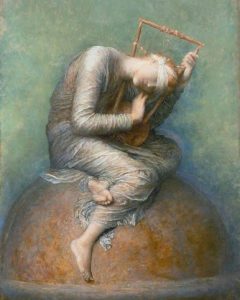
The Storm – Edvard Munch
The setting is the Norwegian seaside, where Edvard mostly spent his vacations. All the characters in this artwork are female. They are covering their ear from the howling sound of the storm. The sky is grayish as it is about to rain but also evokes the element of darkness; the bent trees show strong wind. The escape from the storm is actually the escape from the inner storm. The effect of fear is dominating from which the women are scared of. The dark colors express the feeling of depression.

Mona Lisa – Leonardo Da Vinci
Mona Lisa is one of the favorite and mysterious of most artworks. It is known to be the portrait of Francesco Del Giocondo's wife. The Mona Lisa's enigmatic expression seems both alluring and aloof. Mona Liza's smile is the central motif of the piece. It is this notion that makes it a masterpiece. At the back, the winding roads are symbols of the problems of life. The blurred outlines, graceful figure, dramatic contrasts of light and dark enhance its symbolism. The sitting posture represents the Pyramid image, 'sitting of Maddona'. The arm postures are symbolic of the sense of distance between the spectator and the sitter. The half-smile of Mona Lisa is symbolic of the possible happiness in the world or even pride.
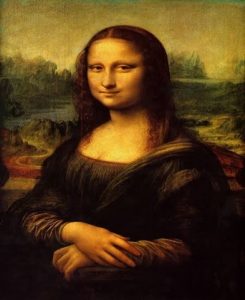
Starry Night – Vincent Van Gogh
This painting is the best representative of the painter's emotions. Many critics agree at this point that the dimness of night sky reflects the painter's quest to overcome his illness. The relation of fire, mist, and water is very well depicted. It is an attempt to express a state of shock, and the cypresses, olive trees, and mountains had acted as painter's catalyst. The hill rose up steep and abruptly now, menacing, threatening to drag the lonesome soul down into vertiginous depths. The tree reaching into the sky is a symbol of the connection between earth and heaven. The movement of the wind is the traveling of the soul.

Go ahead and explore the artworks around you, sometimes they tell you the whole story without any words.

Use of Myth and Symbolism in 20th Century Poetry
Source: https://literarydevices.net/examples-of-symbolism-in-art/